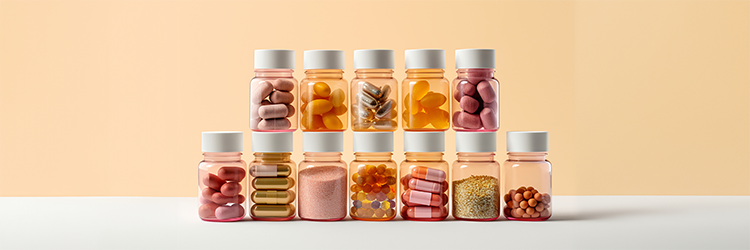
Disclaimer: None of the information in this article constitutes medical advice, and is just the opinion of the writer(s). We recommend that patients follow their doctor’s guidance in regard to pain relief.
Tramadol is a drug in a class called analgesics, which relieve pain. It’s typically prescribed for severe pain disorders or for post-surgery recovery.
Tramadol is the name for the generic version of the medication, but it’s also sold under branded names such as Ultram and Conzip. These terms all refer to the same active drug ingredient, so we will use them interchangeably throughout this article.
But is tramadol actually proven to be effective for pain relief in medical studies? Does it have side effects? How does it work? And how do real users rate and describe its effects?
In this article we'll answer all of these questions and more, as we analyze medical studies on tramadol to determine whether or not the medication is likely to be effective for pain relief.
We'll discuss potential side effects, feature real patient reviews, and explain how and why the Food and Drug Administration (FDA) restricted tramadol.
Does Tramadol Relieve Pain?
Tramadol has been studied in various clinical trials which tested its effects on pain.
A medical review published in the Pharmacological Reports journal evaluated whether or not the medication was effective for reducing pain in both chronic pain patients and cancer patients.
The researchers found that tramadol was effective for both acute and chronic pain:
Patients treated with tramadol reported pain reduction that was “very good” or “good” 89% of the time, and in the four hours after the first tramadol dose, pain scores decreased by over 50%.
A 2000 examined how effective tramadol was for treating perioperative (during or post-surgery) pain. The drug was found to be effective for both children and adult patients.
The efficacy of the drug was similar to morphine, and the study authors concluded that tramadol was effective for “moderate to severe postoperative pain.”
Tramadol has also been for its efficacy in treating musculoskeletal pain, which overlaps with conditions like fibromyalgia and chronic fatigue syndrome.
Tramadol was found in the above-linked study to be more effective than non-steroidal anti-inflammatory drugs (NSAIDs), which are often used as a first-line treatment for musculoskeletal pain.
We can conclude from the available research that tramadol is effective for a variety of pain disorders, which is unsurprising given that it's approved by the FDA for those indications.
The medication is typically only prescribed for moderate or severe pain, because mild pain may be treated with lifestyle changes.
Does Tramadol Cause Side Effects?
The side effect profile of tramadol will vary based on dosage. Higher doses of the drug are generally more likely to cause side effects than lower doses of the drug.
The side effect profile will also vary depending on whether an immediate-release or extended-release version of the drug is used.
A 2010 on tramadol side effects reports that the most common side effects are dizziness, sleepiness, nausea, headache, constipation and vomiting.
The percentage of patients reporting each individual side effect seems to range between 10-20% of patients based on the above-linked research review.
A more concerning, though more rare, potential side effect of tramadol is serotonin syndrome, which can be fatal in some cases. Any medication which increases circulating levels of serotonin increases the risk for serotonin syndrome, and tramadol use can increase serotonin levels.
A 2015 medical review noted the following: “physicians should be aware of tramadol as a potential single-agent cause of serotonin syndrome.” The study authors did not report or predict a percentage of patients that may experience this side effect.
Due to the risk of serotonin syndrome, we strongly recommend that patients on antidepressants should mention their use of this class of drugs to their doctor if they're prescribed tramadol.
What Does Tramadol Feel Like?
An animated video from National Geographic explains what opioids like tramadol feel like, and how they work in the body:
Is Tramadol Addictive?
Because tramadol is an opioid, it has addictive potential.
A published in the BioMed Research International journal examined the potential for tramadol dependence in patients with no history of substance abuse.
The researchers found that addiction to tramadol alone was possible, and suggested that the previously-held notion that only patients with a history of substance abuse were likely to get addicted to tramadol may be false.
Of the patients in the study addicted to tramadol, 90% of them were not using any other drugs concurrently, and 87% had no previous history of drug abuse prior to their tramadol addiction.
The sample sizes in this study were small, so we’re not suggesting it’s conclusive. But tramadol does appear to have addictive potential, which makes logical sense given that it’s an opioid.
Patients with a personal or family history of substance abuse may want to speak with their doctor about other options for pain relief.
Tramadol vs. Oxycodone
Oxycodone is another commonly-prescribed pain medication, so patients are often curious about which treatment is more effective.
While individual results will vary, a 1999 directly compared the effectiveness of the two drugs.
Patients received one of the two drugs after completing facial surgery, and the pain relief effects were compared.
Oxycodone was found to be the more effective treatment, because pain relief was similar between both drugs but oxycodone caused significantly less nausea than tramadol (28% vs. 44%).
A published in the Pharmacology journal reported that tramadol and oxycodone were equally effective at reducing pain in breast cancer patients, but in this study there was no difference in side effect rates.
Based on the available research, we consider the potential efficacy of the two drugs to be similar, as there doesn't seem to be enough information to recommend one over the other on a general basis.
We recommend that patients speak with their doctor about whether tramadol or oxycodone is a better option for them, because genetics and current medications may make one drug more favorable.
FDA Restriction on Tramadol
In 2017, the FDA issued a that tramadol was restricted for use in children and adolescents.
The drug’s label now must carry a warning that the drug should not be used for pain in children under 12 years old.
The FDA also warns that tramadol should not be used for pain in children under 18 years old who have undergone tonsil or adenoid surgery.
The notice further recommends that women avoid breastfeeding while taking tramadol because the drug can be absorbed by the infant from breastmilk, and may cause serious adverse effects, as a baby’s body cannot process opioid medication as efficiently as an adult can.
It seems logical for parents to speak with their pediatrician about non-opioid pain relief options for their children and adolescents given the side effect profile of opioids.
Patients Rate Tramadol
Drugs.com is a website that allows prescription medication patients to rate and review the drugs they're taking.
We cannot verify the accuracy or authenticity of any reviews on this site.
At the time of updating this article, tramadol has been reviewed over 250 times on Drugs.com, and has an average review rating of 5.7 out of 10.
A top positive review of tramadol comes from an anonymous user who gave the medication an 8/10 rating and claims that its lack of effects on mental state is a positive:
“Tramadol is a good medication that can take care of a wide range of pain. This medication is a great sub to addictive meds. A medication that only manages the pain and does not manage your mental state.”
A top negative review of tramadol is written by a user named “Bobby...” who gave the medication a 1/10 rating, and claims that tramadol was not effective for pain relief:
“Good honest hardworking Americans who deserve a few hours a day without pain. Now I am in pain all the time I don’t have insurance, so I pay for all my meds with cash.”
Is the Branded Version Better?
As we discussed in the intro section of this article, tramadol is the generic version of the drug and there are several brand-name versions.
One might assume that brand-name versions of drugs are superior, but medical research shows there is no difference in effectiveness on average.
A published in the JAMA journal analyzed whether generic or branded drugs were more effective, and found them to be “clinically equivalent.”
This makes sense, because both branded and generic drugs contain the same active ingredient(s).
We recommend that patients speak with their doctor about generic tramadol rather than branded versions like Ultram.
Tramadol is likely to be cheaper, and if there’s no greater effectiveness from a more expensive version, it seems to be the better option.
Is Tramadol More Effective With Tylenol?
The combined effect of tramadol and Tylenol have been studied in clinical trials. Both are pain-relieving drugs.
A 2003 found that tramadol and Tylenol were more effective for pain relief when used in combination, than when either medication was used in isolation.
Interestingly, no increased side effects were noted compared to taking tramadol in isolation.
Tylenol is fast-acting and tramadol tends to take longer to take effect, so the reduced time to pain relief may be why the two drugs are rated higher when taken in combination.
Even though Tylenol is available over-the-counter (OTC), we strongly recommend that patients speak with their doctor before taking Tylenol while using tramadol, as there may be long-term health risks.
How Does Tramadol Work?
Tramadol is an opioid, which is one of the most well-studied medication classes for pain relief.
Tramadol binds to opioid receptors in the central nervous system and reduces messages to the brain indicating that the body is in pain, StatPearls.
One secondary benefit of tramadol as an analgesic is that it also may improve serotonin levels, which can contribute positively to mood and further reduce pain.
The above-linked StatPearls review details that tramadol blocks reuptake of serotonin, which increases circulating levels of this neurotransmitter.
This is the same mechanism of action of selective serotonin reuptake inhibitor (SSRI) drugs like Prozac which are prescribed to treat depression.
A more in-depth of tramadol published in the CNS Drugs journal explains that the drug is different from other opioids due to a variety of effects it has on biochemical processes in the body, including its ability to suppress nerve conduction and block voltage-gated sodium ion channels, which contribute to pain.
Tramadol Dosage
Tramadol is prescribed at various doses, and in various formats.
According to the StatPearls resource referenced in the previous section, the immediate release dosage of tramadol is 50 milligrams (mg), while the extended release version of the medication comes in three separate doses: 100 mg, 200 mg and 300 mg.
As suggested by its name, the immediate release version is absorbed and utilized quicker by the body, reaching peak concentration in the body in just under two hours.
The extended release version doesn’t reach peak concentration for 12 hours.
There are that tested daily tramadol doses as high as 800 mg, but this higher dose is shown to cause increased dependence, and we would strongly advise speaking with a physician before considering daily doses that high.
Our Clean Joint Health PicksWe receive compensation when readers purchase the products or services we recommend.

Illuminate Labs Ceylon Cinnamon Extract is our our top joint health supplement.
A 2020 concluded that “Cinnamon could be regarded as a safe supplement to relieve pain.”
Cornbread CBD Lotion is our top joint health skin lotion.
Cannabidiol (CBD) is to be effectively absorbed through the skin, and CBD caused "significant improvements in pain" when applied topically in a 2020 .
Both of the products recommended in this section are entirely free of ingredients that we consider to be unhealthy.
We do not recommend using dietary supplements to treat any specific medical condition related to pain, and we are not suggesting that the products referenced in this section are as effective as tramadol or any other FDA-approved medication for pain relief.
Tramadol FAQs
Is tramadol a narcotic?
Tramadol is a narcotic. A narcotic is a substance used to treat serious pain, which tramadol is FDA-approved to do.
Is tramadol a controlled substance?
the Drug Enforcement Administration (DEA), tramadol is a controlled substance as of August 18th, 2014.
This means there are limits on prescriptions and refills for this medication, and it may be illegal for patients to handle without a prescription depending on their jurisdiction.
Is tramadol an NSAID?
Tramadol is not an NSAID.
It’s an opioid, and is alternatively described as a narcotic. This is evident by the fact that tramadol is not available OTC like many NSAIDs are.
Does tramadol make you sleepy?
Sleepiness is one of the most common side effects of tramadol. It may occur in up to 20% of patients depending on dosage.






















































































































































































































































































































































































































































































































































































































































































































































































































































































































